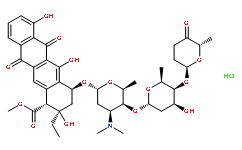| 中文名称: | 盐酸阿柔比星 | ||||
|---|---|---|---|---|---|
| 英文名称: | Aclacinomycin A hydrochloride | ||||
| 别名: | 盐酸阿柔比星 Aclarubicin hydrochloride | ||||
| CAS No: | 75443-99-1 | 分子式: | C42H54ClNO15 | 分子量: | 848.33 |
| CAS No: | 75443-99-1 | ||||
| 分子式: | C42H54ClNO15 | ||||
| 分子量: | 848.33 | ||||
包装规格:
5mg in glass bottle
产品简介:
Aclacinomycin A (Aclarubicin) hydrochloride is a fluorescent molecule and the first described non-peptidic inhibitor showing discrete specificity for the CTRL (chymotrypsin-like) activity of the 20S Proteasome. Aclacinomycin A hydrochloride is also a dual inhibitor of Topoisomerase I and II.
溶解性:
溶于DMSO(≥125mg/mL)
体外研究:
Aclacinomycin A could efficiently enter living cells and emit fluorescence in situ. Aclacinomycin A (10 μM for 15 min) is sufficient for clear detection of fluorescence in most of the cultured cells. Aclacinomycin A treatment (10 μM for 15 min) results in approximately 20% dead (or nearly dead) cells . Aclacinomycin A effectively induces incorporation of exon 7 into SMN2 transcripts from the endogenous gene in type I SMA fibroblasts as well as into transcripts from an SMN2 minigene in the motor neuron cell line NSC34 .
体内研究:
Aclacinomycin A is very well absorbed in mice, rats, and dogs after its oral administration. The oral LD50 (76.5 mg/kg) is about twice the iv LD50 (35.6 mg/kg) in mice. Aclacinomycin A (0.75-6 mg/kg, i.p daily) dose-dependently exhibits tumor growth in mice-based Leukemia P-388 model .
动物实验:
Animal Model: DBA/2, CDF1 (BALB/c×DBA/2) mice with Leukemia P-388. Dosage: 0.75 mg/kg, 1.5 mg/kg, 3 mg/kg, 6 mg/kg. Administration: Intraperitoneal administration daily for 10 days starting 3 hr after transplantation. Result: Inhibited tumor growth .
注意事项:
1、为了您的安全和健康,请穿实验服并戴一次性手套操作。
2、以上信息仅做参考交流之用。
2、以上信息仅做参考交流之用。
保存条件:
-20℃
UN码:
HazardClass:
危害声明:
安全说明:
搜索质检报告(COA)
参考文献 & 客户发表文献
本计算器可帮助您计算出特定溶液中溶质的质量、溶液浓度和体积之间的关系,公式为:
质量 (g) = 浓度 (mol/L) x 体积 (L) x 分子量 (g/mol)
摩尔浓度计算公式
用本工具协助配置特定浓度的溶液,使用的计算公式为:
开始浓度 x 开始体积 = 最终浓度 x 最终体积
稀释公式
稀释公式一般简略地表示为:C1V1 = C2V2 ( 输入 输出 )








